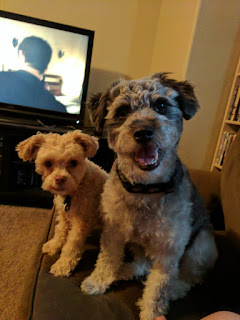The Importance of Differentiation
One of the best decisions that my boyfriend and I have made was adopting our two dogs Of course, we would have gotten dogs much sooner if our previous apartment leases allowed it, but it worked out since we wouldn't have gotten our beloved maltipoos, Leeroy Jenkins and Pacha.
To spin means to turn or whirl around. Both Leeroy and Pacha are turning and whirling, but are doing so according to their strengths. If my boyfriend hadn't stepped in and made me realize that Pacha needed differentiated instruction, I probably would have ended up thinking Pacha is dumb; he wasn't doing the trick based on my own interpretation.
 |
| Pacha is on the left and Leeroy is on the right. |
If you have ever had dogs or any animal, you know that every one has a unique and different personality. For example, Leeroy is the goofy and inquisitive older brother who has immense focus and moose-like characteristics (we were told he would be at most ten pounds and currently he is pushing 25). Pacha, on the other hand, is cuddly and sweet little brother who is really the mastermind behind most crimes committed in the apartment.
I never expected that I would have to use teaching strategies and techniques with my dogs. Of course there are the classic ones, like clear and consistent expectations, rewards and consequences, equity, patience, trial and error, and repetition of tasks. But the one that I really surprised me: DIFFERENTIATION.
Differentiation is one of those words that every teacher knows and makes for effective instruction. For any non-teachers, differentiated instruction is a method of designing and delivering instruction to best reach each student. It can be based on content, instruction, product, assessment, and even classroom design, which can be easily done with project-based learning.
 |
| An example of assessment that is not differentiated for the 'students'. |
My boyfriend and I agreed that we wanted our dogs to be well-trained so within a few hours of getting them, we started training them. Since Leeroy and Pacha are not actually brothers and are five months a part, Leeroy set my expectations for training; he is very focused, eager to please, and a fast learner. But when we got Pacha, I realized that the techniques I used for Leeroy did not work for Pacha, who is an energetic cuddle bug.
We quickly realized that Pacha is a little 'dancer' with incredible balance and a constant desire to be on his hind legs. As a result, dance was one of Pacha's first tricks while it was a later one for Leeroy. But Pacha's eagerness to dance made other tricks more difficult, particularly spin.
When Leeroy learned spin, I put the treat by his butt and he would chase it. So when it was time for Pacha to spin, I did the same method, thinking 'hey, it worked for Leeroy'.
Guess what?
It didn't work.
I tried and tried again, but no matter how many times I put that treat by Pacha's butt he would look at it, look at me, and start his 'dancing'. My boyfriend, also a teacher, ended up intervening and utilized Pacha's desire to dance to integrate spin. Below are their comparisons:
Of course training my dogs is very different from teaching my students, but this experience was a powerful reminder that differentiation is essential in learning. Students are individuals with their own interest and skills and these differences should not be ignored. In the classroom, it so important for teachers to differentiate by building relationships with their students, providing students with voice and choice in instructional design, and ensuring that assessment is free of teacher bias.


Comments
Post a Comment